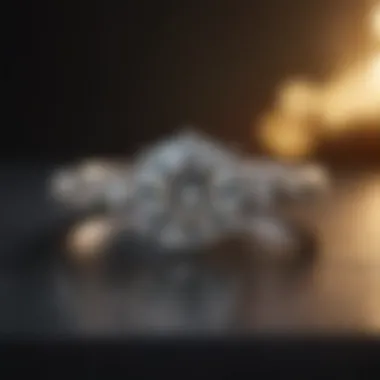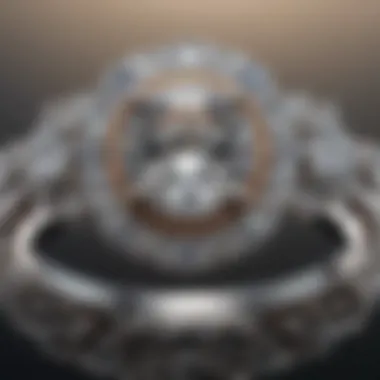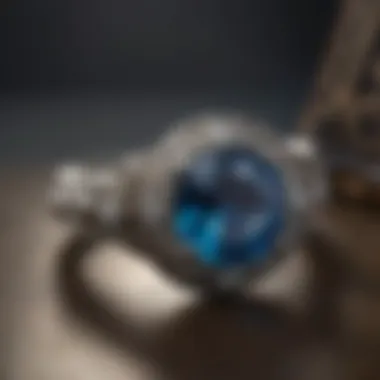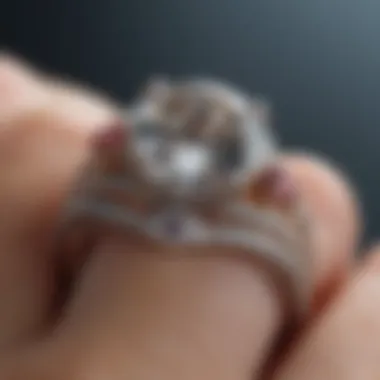Explore Stunning Engagement Ring Setting Options


Intro
When it comes to engagement rings, the choice of setting plays a crucial role. It is not just about holding the gemstone in place but also about enhancing its beauty and suiting the personal style of the wearer. The world of engagement ring settings is diverse, ranging from classic solitaires to intricate vintage designs and modern artistic interpretations. Understanding these various options allows prospective buyers to make an informed decision that aligns with their preferences and values.
This guide will explore different types of settings, discussing their characteristics, advantages, and aesthetic implications. We will begin with an overview of gemstones, as they are the centerpiece of every engagement ring. Understanding the qualities of a gemstone can significantly influence the choice of setting and the overall appeal of the ring.
Gemstone Overview
Definition and characteristics
A gemstone is a piece of mineral crystal which, in cut and polished form, is used to make jewelry or other adornments. Gemstones are categorized not only by their mineral composition but also by their aesthetic properties such as color, clarity, cut, and carat weight. Each gemstone possesses unique characteristics that influence its appearance and value.
Classification of gemstones
Gemstones are typically classified into two categories: precious and semi-precious. While the division is somewhat historical and now less relevant, it is still widely recognized.
- Precious gemstones: These include diamonds, rubies, sapphires, and emeralds. They are valued for their rarity and often considered the top choice for engagement rings.
- Semi-precious gemstones: This category includes a broader range of stones like amethyst, garnet, aquamarine, and topaz. These stones can offer unique beauty and individuality at often lower prices.
Understanding these classifications helps buyers appreciate the options available to them, whether they prioritize traditional values or seek something unusual.
Properties of Gemstones
Physical properties
The physical properties of gemstones define how they interact with light and their overall durability. Key physical attributes include:
- Hardness: Measured on the Mohs scale, hardness indicates resistance to scratching. Diamonds score the highest at 10, making them ideal for everyday wear.
- Luster: This describes the way light reflects off the surface. Gemstones can exhibit different types of luster, from vitreous to silky.
- Transparency: Ranges from completely transparent to opaque. This affects how light interacts with the stone and influences its color perception.
Chemical properties
The chemical properties of gemstones relate to their composition and stability. These properties impact their color, clarity, and potential for treatment processes, which can enhance or alter their appearance.
- Crystal Structure: The internal arrangement of atoms can create distinct shapes, affecting how gems are cut and set.
- Color: Color is primarily due to the light absorption characteristics based on the gemstone's chemical composition. Variations in impurities can lead to different shades.
Knowing these properties aids consumers in making appropriate selections based on lifestyle and preference. For someone leading an active lifestyle, selecting a durable gemstone and suitable setting becomes indispensable.
As we delve further into engagement ring settings in the subsequent sections, this foundational knowledge about gemstones will inform practical and aesthetic decisions suitable for every prospective buyer.
Prelims to Engagement Ring Settings
The engagement ring is often one of the most significant pieces of jewelry a person will ever own, symbolizing love and commitment. Understanding the importance of engagement ring settings is key when choosing the perfect piece. The setting determines not only the aesthetics of the ring but also its durability and comfort. With multiple options available, it is crucial to explore each type's characteristics and benefits. This section serves as a foundational overview of the various settings, highlighting why they matter and how they can align with personal style and lifestyle.
Understanding the Importance of Ring Settings
Ring settings serve as the framework for the gemstones. They provide support and security to the stone while allowing it to shine. A well-chosen setting enhances the overall appearance of the ring, showcasing the stone's beauty. Moreover, the setting can impact the ring's wearability. For example, low-profile settings tend to be more comfortable and practical for everyday wear, while more ornate types might appeal to those seeking a unique statement piece.
In addition, the choice of a specific setting can communicate individual values or aesthetics. For those who prioritize sustainability, certain settings might pair better with ethically sourced materials. By understanding and considering these elements, buyers can craft a ring that truly resonates with their personal identity.


Historical Evolution of Engagement Ring Settings
The history of engagement rings dates back centuries, evolving with cultural trends and societal norms. Early on, rings were simple bands, often made of woven grass or leather, signifying bond and unity. As precious metals became more accessible, gold and silver started to replace these materials, allowing for more intricate designs.
During the Renaissance, the introduction of gemstone settings began. The use of diamonds and other precious stones symbolized wealth and status. The solitaire setting gained popularity in the 19th century, emphasizing a single diamond, representative of the idea that one love is paramount.
In recent decades, the engagement ring setting has diversified significantly. The rise of custom jewelry has led to innovative designs, catering to personal preferences and unique tastes. As cultural influences shift, so do the styles we embrace, making the study of these changes in settings crucial for anyone interested in engagement rings. Greater awareness of historical trends can inform better decisions, ensuring a chosen ring reflects not just modern sensibilities but also a rich heritage.
Classic Setting Options
Classic setting options hold significant importance in the realm of engagement rings. These traditional styles have endured through time, serving as cherished symbols of commitment and love. They emphasize the central gemstone while providing a timeless elegance that continues to captivate couples. Many prospective buyers appreciate the familiarity and heritage these settings represent. Choosing a classic option often means opting for enduring designs that easily replace trends with lasting beauty.
Solitaires: The Timeless Choice
The solitaire setting is regarded as the quintessential choice for engagement rings. It features a single gemstone, typically a diamond, prominently displayed atop the band. This simplicity allows the stone's brilliance to take center stage, making it an ideal choice for those who value minimalism. A solitaire setting is versatile and harmonizes well with various band styles and metals.
Benefits of Solitaires:
- Elegance: The focused design of solitaires enhances the beauty of the stone.
- Customization: Available in numerous shapes and sizes, allowing for personalization.
- Legacy: Timeless appeal makes it a favored choice across generations.
Halo Settings: Enhancing the Center Stone
Halo settings have gained popularity in recent years for their ability to enhance the central gemstone's size and brilliance. This design features a center stone surrounded by smaller stones, often diamonds, creating a striking frame. The halo effect not only increases the visual size of the center stone but also adds an extra layer of sparkle.
Considerations for Halo Settings:
- Visual Impact: The surrounding stones create an illusion of a larger center stone.
- Customization Options: Various styles are available, allowing for individual taste expression.
- Maintenance: Requires regular cleaning to maintain brilliance, as smaller stones can attract dirt.
The halo setting is distinct for those seeking a dramatic appearance while keeping the focus on the central stone.
Three-Stone Settings: Signifying the Past, Present, and Future
Three-stone settings stand as a powerful symbol of a couple’s journey together. This design features three stones, usually representing the past, present, and future of the relationship. The stones can be of identical size or different dimensions, allowing for a unique representation of the bond.
Advantages of Three-Stone Settings:
- Meaningful Design: Each stone denotes a significant moment in the relationship.
- Personalized Variations: Flexibility in the choice of stones contributes to an individualized design.
- Balanced Aesthetics: The configuration provides a balanced look that is both elegant and meaningful.
Three-stone settings appeal to couples who appreciate symbolic meaning in their jewelry, making it a defining choice for engagement.
Modern and Unique Settings
As style evolves, so too do the preferences for engagement ring settings. Modern and unique settings have become increasingly popular among individuals seeking something that stands out. These settings provide a way to express personal taste while still creating a meaningful symbol of commitment. Often, they break away from traditional designs, offering innovative features that cater to contemporary lifestyles. The ability to customize rings reflects deeper values related to individuality and sustainability, which appeals to today's gemstone enthusiasts.
In this section, we will explore three specific types of settings: Bezel Settings, Tension Settings, and Unique & Custom Settings. Each setting offers distinctive attributes which may resonate with different preferences and lifestyles.
Bezel Settings: A Contemporary Take
Bezel settings are a modern choice that encapsulates the diamond or gemstone within a metal rim. This type of setting provides a minimalist approach while ensuring the stone is secure. The sleek design allows for a clean, contemporary look that many find appealing.


The practicality of bezel settings enhances their allure. They help protect the gemstone from chips and scratches, making them suitable for active individuals. Moreover, bezels can encase various shaped stones, allowing for creativity in selection. The clean edges create a striking contrast, which can highlight the gem’s brilliance.
"Bezel settings merge functionality with modern aesthetics, ensuring the gemstone is both beautiful and protected."
Tension Settings: The Art of Suspension
Tension settings represent a balance of engineering and artistry. Unlike traditional settings, this design suspends the diamond or gemstone between two ends of the band. It creates an illusion of the stone floating, contributing to a unique look.
This innovative approach provides a significant visual impact. Light can pass through the gemstone from all directions, enhancing its brilliance. However, the precision required to create a tension setting makes it a more challenging option. Suitable for diamonds or harder gemstones, this setting may not be ideal for softer stones due to its unique constraints.
Individuals looking for a bold statement piece often lean toward tension settings, appreciating that such designs can convey a sense of modernity and sophistication.
Unique and Custom Settings: Expressing Individuality
For those who desire a special mark of their relationship, unique and custom settings offer an excellent solution. These settings are tailored to the individual's tastes, incorporating personal elements such as engravings, birthstones, or unconventional materials.
Creating a unique piece allows for deep personal expression. Couple can discuss design options with jewelers, ensuring their vision comes to life. This process not only includes setting choices but also metal types, stone shapes, and any additional features desired.
Furthermore, as more consumers demand ethical practices, custom settings allow individuals to choose sustainable options. Lab-grown diamonds, for example, can be integrated seamlessly into a custom design, aligning with personal values.
In summary, modern and unique settings provide compelling options for engagement rings. Bezel, tension, and custom settings not only reflect personal taste but also integrate functionality and modernity. These settings resonate well with people seeking to make a statement while ensuring the ring remains meaningful and practical.
Personal Considerations in Choosing a Setting
Engagement rings represent significant milestones in relationships, making the choice of setting a deeply personal decision. The consideration of various personal factors is essential in finding the right ring that not only reflects individual style but also complements one's lifestyle and values. This section delves into crucial aspects that should guide buyers in making informed choices when selecting their engagement ring settings.
Lifestyle Compatibility
When it comes to choosing an engagement ring setting, one must first think about their lifestyle. Different settings offer varying levels of durability and maintenance. For example, individuals engaged in active professions or sports may prefer rings with lower profiles, such as bezel settings or tension settings. These designs are less likely to snag on clothing or equipment, thus providing better protection for the stone.
On the other hand, someone who leads a more sedentary lifestyle might opt for more elaborate styles like halo or three-stone settings, which, while stunning, may require more maintenance. Understanding how frequently one will wear the ring and in what conditions plays a key role in this decision.
"Choosing a setting that aligns with your daily activities ensures longevity and preserves the emotional value of the ring."
Metal Choices: Gold, Platinum, or Alternative Alloys
The type of metal used in the setting also holds significant importance. Gold, platinum, and alternative alloys each bring distinct characteristics to an engagement ring.
- Gold: Available in yellow, white, and rose variants, gold is an enduring choice. Its malleability allows for intricate designs. However, it may require regular polishing to maintain its shine.
- Platinum: Known for its strength and durability, platinum is hypoallergenic and has a naturally white sheen that pairs well with a variety of gemstones. Its weight can be noticeable, which some individuals appreciate.
- Alternative Alloys: Options like titanium or stainless steel are becoming popular for their unique appearance and affordability. These materials often provide excellent durability, demanding less upkeep.
When selecting a metal, personal preferences, budget constraints, and skin sensitivities should all factor into the decision.
Stone Dimensions and Characteristics
Finally, the dimensions and characteristics of the stone should not be overlooked. Cut, carat weight, clarity, and color significantly influence the overall appearance and brilliance of a ring. Depending on personal taste, some may prefer a larger, more prominent stone, while others may find elegance in a smaller, more delicately set gem.
Additionally, the shape of the stone affects how it interacts with light and perception. Round, princess, or oval shapes tend to exhibit different sparkling qualities. Understanding these variations allows buyers to select a stone that reflects their personal aesthetic beautifully.
Ethical and Environmental Considerations


In recent years, the conversation around ethical and environmental considerations in the jewelry industry has gained significant traction. The engagement ring is often seen as a symbol of love and commitment, but the choices made during its creation can have profound impacts on the environment and communities involved in the sourcing of materials. Understanding these implications is crucial for informed consumers who wish to align their purchases with their personal values.
Sourcing Responsible Materials
Sourcing responsible materials is an essential aspect of purchasing an engagement ring. Traditional mining practices for precious metals and gemstones can lead to environmental degradation and human rights violations. For example, mining operations often disrupt local ecosystems, pollute water sources, and displace communities. To counteract these negative effects, many jewelers now focus on ethically sourced materials.
When shopping for an engagement ring, look for certifications that indicate responsible sourcing. Brands that adhere to ethical sourcing standards often provide transparency about their supply chains. Fair Trade Gold, for instance, ensures that the gold is mined under fair labor conditions, with environmentally friendly practices. Furthermore, some jewelers offer reclaimed or recycled materials, which reduce the need for new mining.
Using responsible materials not only has a positive environmental impact but also supports sustainable practices in the jewelry industry.
Lab-Grown vs. Natural Stones
The debate between lab-grown and natural stones is a pivotal topic in the realm of engagement rings. Both options come with their own sets of advantages and considerations.
Lab-grown diamonds, created in controlled environments, are chemically identical to natural diamonds. They often come at a lower price point and are marketed as having a smaller environmental footprint. Importantly, lab-grown stones eliminate concerns about unethical mining practices, making them appealing to environmentally-conscious buyers.
On the other hand, natural stones hold intrinsic value and uniqueness. Each natural diamond or gemstone carries its own story, derived from the earth it came from. However, they can be tied to mining practices that may be harmful to communities and environments.
Buyers must weigh these options carefully. Choosing lab-grown stones can align with ethical considerations, while natural stones may appeal to those valuing tradition and rarity. Ultimately, both choices can be part of an ethical purchasing process when sourced responsibly.
"Informed decisions lead to thoughtful purchases, fostering a more sustainable and ethical jewelry industry."
By prioritizing ethical and environmental considerations, consumers not only enhance their engagement ring choices but also contribute to a broader shift in the industry towards sustainability and responsibility.
Caring for Your Engagement Ring
Caring for your engagement ring is crucial for preserving its beauty and longevity. This piece of jewelry is often worn daily, exposed to elements that can cause wear and tear. A well-maintained ring not only retains its sparkle but also reflects the emotional significance it holds. Regular care practices can prevent the build-up of dirt and grime and protect the stone from damage. Understanding how to properly care for your engagement ring can enhance its appearance and ensure it remains a treasured item for years to come.
Regular Maintenance and Cleaning
Regular maintenance of your engagement ring involves simple practices that keep it looking its best. It is recommended to clean your ring at least once a month, though frequent wearers may need to do this more often.
- Use a Soft Brush: A soft bristle toothbrush can help remove daily grime. Make sure to use gentle movements to avoid scratching the metal or stones.
- Soak in Soapy Water: Mix mild soap with warm water and soak the ring for about 20 minutes. This gentle solution can help loosen any built-up dirt without risking damage.
- Rinse and Dry: After soaking, rinse the ring under lukewarm water. Pat it dry with a soft cloth, avoiding paper towels which might scratch the surface.
Consider using a professional cleaning service periodically. They can provide a deep clean and check for any potential issues that may need special attention.
Signs of Damage and When to Seek Professional Help
Even with perfect care, engagement rings can suffer damage over time. It is vital to recognize signs that indicate a need for professional assistance.
- Loose Stones: If you notice that a diamond or gemstone is shifting, it may be loose in its setting. This can lead to loss if not addressed promptly.
- Scratches on Metal: Over time, the metal can develop scratches. While minor scratches can often be polished out at home, deep scratches usually require professional care.
- Discoloration: Gold or platinum settings may become dull or tarnished. This discoloration can happen due to exposure to lotions and soaps. Professionals can restore the original luster.
- Chips or Cracks in Stones: If you observe any damage to the stone, it is essential to seek help from a jeweler immediately. Repairs may be necessary to avoid further damage.
Regular checks and timely interventions can make a significant difference in the preservation of your engagement ring. A proactive approach ensures that this symbol of love remains breathtaking and intact for a long time.
Closure
Choosing an engagement ring setting is not just about aesthetics; it represents deep emotional underpinnings and a commitment to a shared future. The conclusion of this guide aims to crystallize the importance of making an informed decision. It is paramount that couples understand the multifaceted aspects of engagement ring settings. Each choice, from the traditional solitaire to the more modern tension setting, carries its own significance and character.
When selecting an engagement ring, consider elements such as lifestyle compatibility, ethical sourcing, and personal style. These factors will influence your chosen design, ensuring it reflects both individuality and values.
Moreover, the ring's sustainable considerations have gained newfound relevance in today's marketplace. Consumers are increasingly mindful of where their materials are sourced and the impact their choices have on the environment. Understanding the balance between beauty, ethics, and personal significance equips buyers with the knowledge to navigate the myriad of options available.
"An engagement ring is not just a piece of jewelry; it is a symbol of love, commitment, and shared values."
In summary, this guide underscores the various operational elements involved in selecting the perfect setting. It illustrates that an educated approach empowers the buyer, allowing you to choose a setting that resonates deeply with your personal values and mutual aspirations. Ultimately, an informed decision results in a ring that embodies both beauty and meaning.



